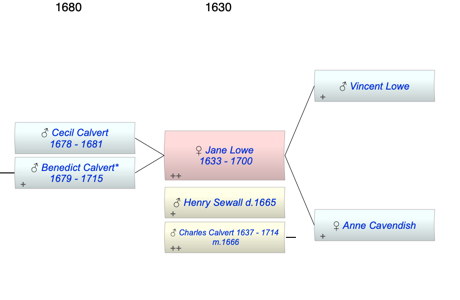1 son & 4 daughters with Henry
Charles' second of 4 wives, they had 3 sons 2 daughters.
"George Calvert and Cecilius Calvert, Barons Baltimore of Baltimore" by Wm. Hand Browne, Dodd, Mead and Company, New York, 1890. p 45, re the Ark and Dove's sailing in 1633, indicating that the Jesuit Priests and the bulk of the Catholic passengers came aboard at the Isle of Wight. "A careful weighing of all the evidence leads to the conclusion that the settlers proper-those who took up lands-were nearly all Catholics, while the majority of the labouring men, and of the whole colony, were Protestants." "As a large part of the settlers were persons held to service, it seems most likely that the planters who embarked at the island had their servants and labourers with them, and saw them on board. The heads of the expedition were Leonard Calvert, the proprietary's brother and governor of the Colony, and two Catholic gentlemen, Jerome Hawley and Thomas Cornwaleys, commissioners or coadjutors/ George Calvert, a younger brother, accompanied them, and died not long after in Maryland or VA."
From Paul Tobler's notes, quoting from the Maryland Hist. Mag., Vol.22, p. 323, in a note states:
"Cecilius, Lord Baltimore, had some connection with Samson Calvert of St. Dunstans in the West, London, in 1645. Samson had entered Oxford 1623, aged 20, and was the son of one George Calvert and a brother of Thomas Calvert of All Hallows in the Wall, London, whose estate was administered 1637 by his widow Judith and his brother Samson. A Rev. Samson Calvert, was in the Colony of Virginia as early as 1649. (See Book IX) further from Paul's notes:
From Dictionary of Christianity in America. page 209/10. Catholic colonizer of Maryland. Born in London in 1606, Cecilius or Cecil, was the eldest son of George Calvert, Baron of Baltimore in Ireland. On his father's death in 1632, Cecilius succeeded to the title. He immediately began to realize his father's dream of establishing a colony in America as a refuge for his fellow Catholics. On Nov. 22, 1633, Calvert dispatched to Maryland two ships, the Ark and the Dove, with between 200-300 settlers abroad, the majority of them Protestants. Among these were the Jesuit priests Andrew White and John Altham, accompanied by a lay brother Thomas Gervase. Determined to avoid religious strife in the new colony, Cecilius instructed his brother Leonard Calvert who, he had appointed governor, that all settlers were to be granted religious liberty. He invited the Society of Jesus to care for the spiritual needs of Maryland's Catholics provided they construct self-supported missions, land for which they would obtain from him. When the Jesuits insisted on their right to acquire unlimited land grants from the Indians, Cecilius pressured the Jesuit General to order his subjects to conform to proprietary law and to grant the proprietor a veto over missionaries assigned to the colony. During the English Civil War Maryland was seized Virginia Puritans who expelled Governor Leonard Calvert. He regained control of the colony but died shortly thereafter in 1647. To diffuse religious tension, Cecilius appointed as Governor a Protestant, William Stone, in 1648. When Charles I was executed in Jan 1649 and the Commonwealth created, Calvert wrote "The Act Concerning Religion" adopted by the colony on April 21, 1649, which was designed to allay Puritan suspicions and save his proprietorship. Though Virginia Puritans again seized Maryland in 1655, it was returned to him in 1658. Calvert died in London on November 30, 1675. .
From: History of Early Maryland, by Rev. Theodore C. Gambrall, A. M., D.D. Published by Thomas Whittaker, New York, 1893 http://members.tripod.com/~jweaver300/md/hemd.htm#2: Lord Baltimore, who had learned experience by his father's attempts in Newfoundland, and by his association with the Virginia Company, spent, we are told, forty thousand pounds sterling in getting his colony firmly and definitely started; a venture that very few would have felt themselves justified in making even if they had the ability. Colonization by the English was a new thing, and for its success required boldness as well as large resources. Besides, Lord Baltimore, being the sole grantee of the charter, was not hampered by a multitude of counsellors, among whom there will always be some doubtful and timid spirits, and some who, if not doubtful and timid, can always find some reason for questioning every proposition. Doubtless one great cause why Maryland and Pennsylvania succeeded so well, was that in each case one man was at the head of affairs, and so all rivalry and jealousy in the source of administration, were avoided. |

 +=
+= 